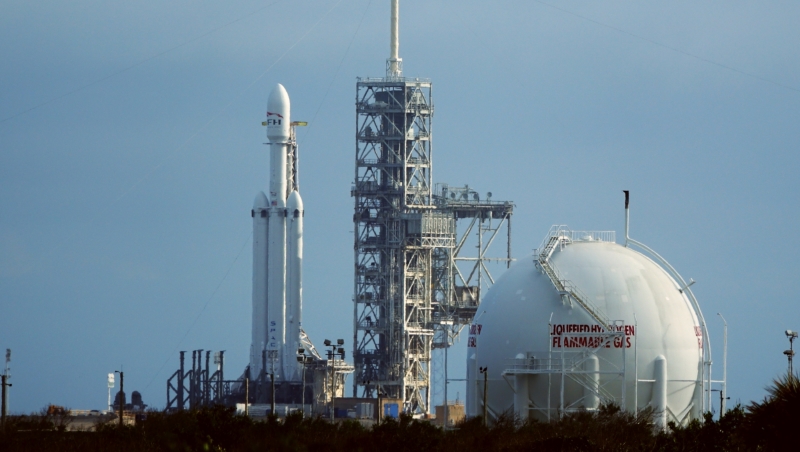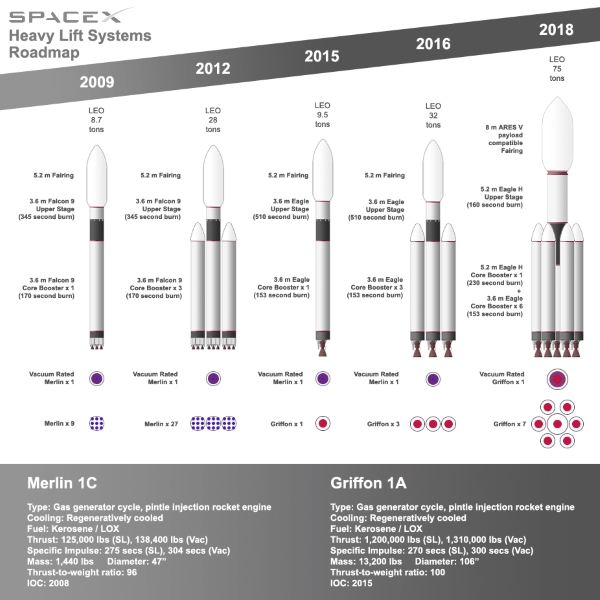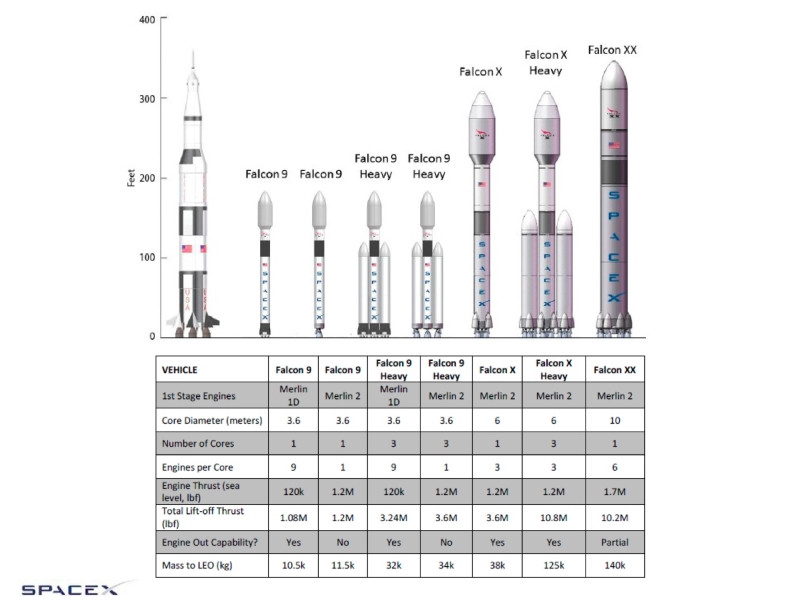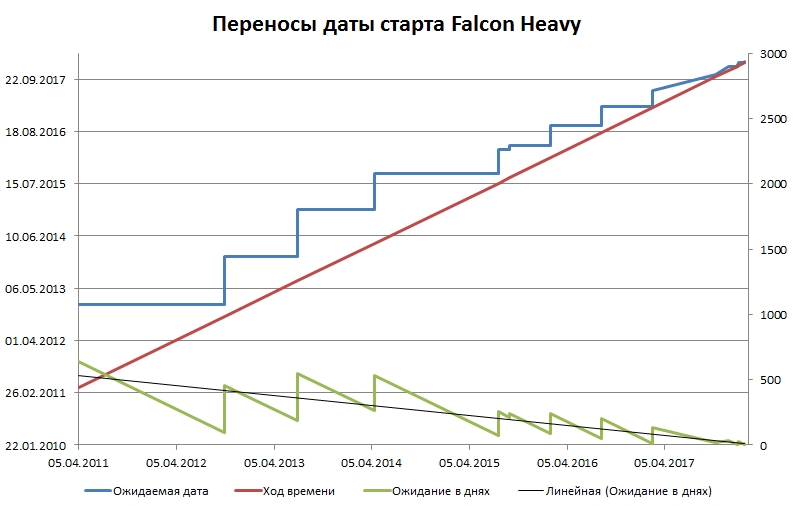What you should know before the first flight Falcon Heavy
This whole week will be marked by the expectation of the first launch of the heavy (sometimes already called super-heavy) Falcon Heavy rocket. Therefore, I think, a brief story about the history of the rocket and the features of the upcoming launch will be useful.

Falcon Heavy on the launch pad, photo by Derrick Stamos / NSF
The idea of a heavy rocket of the three first-ranked first stages was mentioned by Mask as much in 2005, when the concept of the Falcon 5 rocket with five engines turned into a Falcon 9 project with nine. Then its capacity was estimated at 25 tons. According to the old SpaceX illustrations, it is clear that the designers were going to create a very powerful engine with a load in the region of 500 tons and replace them with the Merlins, on which the Falcon missiles have been flying from inception to the present.

Figure SpaceX, roughly the end of the zero
')

Figure SpaceX, the beginning of the tenth
The idea of a "flying fence" of the three universal modules at that time was the fashion mainstream - it was designed for the Delta IV Heavy, the Angara was developed, and the same modification was proposed for Atlas V. Officially, the Falcon Heavy was introduced on April 5, 2011.
Pay attention to how much in the video the first step of the Falcon 9 differs from the modern version. It is shorter (lower engine thrust and less fuel), engines are arranged in a 3x3 square, and there are no landing supports. At the same time, Falcon Heavy wanted to implement a truly unique technology - overflow of fuel from the side blocks to the central one. In this case, after the separation of the side blocks, the central one would retain full tanks, which would have a positive effect on the payload and efficiency of the rocket. Alas, real life is more complicated than the rocket-building game Kerbal Space Program, they could not realize the idea, and now Falcon Heavy will throttle (reduce thrust) the engines of the central unit, with incomplete tanks, its work area will be shorter, and its efficiency will be lower.
From the fifth of April 2011, the long-term waiting for the first flight started, which became a vivid illustration of the fact that it was difficult to create the equipment, and the priority plans changed. Instead of quickly building a Falcon Heavy SpaceX, it was engaged in improving Falcon 9 and reusable first steps. If at first many still believed in the above mentioned dates, then after several years the next postponement of the first flight date of the Falcon Heavy was perceived with irony.

Postponement Schedule
For boredom, enthusiasts processed data using statistical methods and obtained a calculated launch date around mid-February of this year. It will be funny if the start of the 6th day is postponed, and as a result, the rocket will be launched in the time predicted by the results of years of promises.
Alas, another beautiful idea died as a result of a collision with reality - to make the central and side blocks completely identical. Calculations showed that without amplification the central unit would not sustain the load. As a matter of fact, it is the in-flight load that will be the main risk for a rocket - any calculations on computers can give only approximate numbers, and besides, some parameter could be incorrectly taken into account. But the problems of a large number of engines should not be afraid. Only catastrophic destruction can be dangerous, because in other cases the control system will reduce the thrust from the opposite side and stabilize the flight. Sometimes 27 Falcon Heavy engines are compared with 30 at the first stage of the Soviet N-1, all four start-ups of which failed, but this is incorrect. The N-1 was very unlucky, its engines were checked before launching incorrectly and insufficiently, and there were no test benches for checking the first stage assembly. In general, a lot of engines can even increase safety, provided that after the failure of one thrust, there is enough remaining to continue the flight. In the history of Falcon 9, there was a case of engine failure in 2012. At that time, the control system coped with the indignation, and only the secondary payload was lost (the main ship, the Dragon ship, successfully flew to the ISS).
It should also be noted that the official load capacity figures of 63.8 tons are listed for the fully one-off option. In the autumn presentation at the International Astronautical Congress for the reusable version, a loading capacity of 30 tons was announced. This is not surprising - the supply of fuel for landing steps seriously reduces the maximum possible payload. However, so far, and thirty tons will make the Falcon Heavy the most lifting rocket.
In the first test launch, two side-mounted stages already set up with side blocks. It is also planned to land all three blocks - the side will have to return to Cape Canaveral and land on the ground, and the central block will land on the barge. But the third stage will be lost - in the spring of 2017, Musk wrote that they would try to save her, but in the end they chose to accelerate the stage and payload to the second cosmic velocity and send it beyond the Earth's orbit.

Photo: SpaceX
The personal load in the test launch will be the personal Tesla Roadster Ilona Mask 2009. On test flights, real satellites are rarely placed, and the option to send a car into space is useful from the point of view of PR and looks better than a weight-scale layout. This will not be the first car to leave the Earth on a rocket - Top Gear had time before, but in case of luck, the car will be the first in orbit. Contrary to the words of Mask that the Roadster will be sent to the orbit of Mars, the car will be in heliocentric (around the Sun) orbit between the Earth and Mars. And if Musk is a real troll, then he will say that he put the kettle in the trunk.
The launch will take place from Cape Canaveral’s historic LC39A launch complex, where Saturn V and Space Shuttles started. Buzz Aldrin, who flew from the same site as part of the Apollo 11 crew, and Harrison Ford, who piloted the movie “Millennium Falcon” (Falcon translates as “falcon”), were called honorary guests. The three-hour window, starting from 21:30 Moscow time on February 6, is indicated as the start time. Regardless of the result, the launch of the Falcon Heavy will really be an interesting sight.

Falcon Heavy on the launch pad, photo by Derrick Stamos / NSF
Long wait
The idea of a heavy rocket of the three first-ranked first stages was mentioned by Mask as much in 2005, when the concept of the Falcon 5 rocket with five engines turned into a Falcon 9 project with nine. Then its capacity was estimated at 25 tons. According to the old SpaceX illustrations, it is clear that the designers were going to create a very powerful engine with a load in the region of 500 tons and replace them with the Merlins, on which the Falcon missiles have been flying from inception to the present.

Figure SpaceX, roughly the end of the zero
')

Figure SpaceX, the beginning of the tenth
The idea of a "flying fence" of the three universal modules at that time was the fashion mainstream - it was designed for the Delta IV Heavy, the Angara was developed, and the same modification was proposed for Atlas V. Officially, the Falcon Heavy was introduced on April 5, 2011.
Pay attention to how much in the video the first step of the Falcon 9 differs from the modern version. It is shorter (lower engine thrust and less fuel), engines are arranged in a 3x3 square, and there are no landing supports. At the same time, Falcon Heavy wanted to implement a truly unique technology - overflow of fuel from the side blocks to the central one. In this case, after the separation of the side blocks, the central one would retain full tanks, which would have a positive effect on the payload and efficiency of the rocket. Alas, real life is more complicated than the rocket-building game Kerbal Space Program, they could not realize the idea, and now Falcon Heavy will throttle (reduce thrust) the engines of the central unit, with incomplete tanks, its work area will be shorter, and its efficiency will be lower.
From the fifth of April 2011, the long-term waiting for the first flight started, which became a vivid illustration of the fact that it was difficult to create the equipment, and the priority plans changed. Instead of quickly building a Falcon Heavy SpaceX, it was engaged in improving Falcon 9 and reusable first steps. If at first many still believed in the above mentioned dates, then after several years the next postponement of the first flight date of the Falcon Heavy was perceived with irony.

Postponement Schedule
For boredom, enthusiasts processed data using statistical methods and obtained a calculated launch date around mid-February of this year. It will be funny if the start of the 6th day is postponed, and as a result, the rocket will be launched in the time predicted by the results of years of promises.
Tribute to complexity and physics
Alas, another beautiful idea died as a result of a collision with reality - to make the central and side blocks completely identical. Calculations showed that without amplification the central unit would not sustain the load. As a matter of fact, it is the in-flight load that will be the main risk for a rocket - any calculations on computers can give only approximate numbers, and besides, some parameter could be incorrectly taken into account. But the problems of a large number of engines should not be afraid. Only catastrophic destruction can be dangerous, because in other cases the control system will reduce the thrust from the opposite side and stabilize the flight. Sometimes 27 Falcon Heavy engines are compared with 30 at the first stage of the Soviet N-1, all four start-ups of which failed, but this is incorrect. The N-1 was very unlucky, its engines were checked before launching incorrectly and insufficiently, and there were no test benches for checking the first stage assembly. In general, a lot of engines can even increase safety, provided that after the failure of one thrust, there is enough remaining to continue the flight. In the history of Falcon 9, there was a case of engine failure in 2012. At that time, the control system coped with the indignation, and only the secondary payload was lost (the main ship, the Dragon ship, successfully flew to the ISS).
It should also be noted that the official load capacity figures of 63.8 tons are listed for the fully one-off option. In the autumn presentation at the International Astronautical Congress for the reusable version, a loading capacity of 30 tons was announced. This is not surprising - the supply of fuel for landing steps seriously reduces the maximum possible payload. However, so far, and thirty tons will make the Falcon Heavy the most lifting rocket.
In the first test launch, two side-mounted stages already set up with side blocks. It is also planned to land all three blocks - the side will have to return to Cape Canaveral and land on the ground, and the central block will land on the barge. But the third stage will be lost - in the spring of 2017, Musk wrote that they would try to save her, but in the end they chose to accelerate the stage and payload to the second cosmic velocity and send it beyond the Earth's orbit.
Red show off

Photo: SpaceX
The personal load in the test launch will be the personal Tesla Roadster Ilona Mask 2009. On test flights, real satellites are rarely placed, and the option to send a car into space is useful from the point of view of PR and looks better than a weight-scale layout. This will not be the first car to leave the Earth on a rocket - Top Gear had time before, but in case of luck, the car will be the first in orbit. Contrary to the words of Mask that the Roadster will be sent to the orbit of Mars, the car will be in heliocentric (around the Sun) orbit between the Earth and Mars. And if Musk is a real troll, then he will say that he put the kettle in the trunk.
The launch will take place from Cape Canaveral’s historic LC39A launch complex, where Saturn V and Space Shuttles started. Buzz Aldrin, who flew from the same site as part of the Apollo 11 crew, and Harrison Ford, who piloted the movie “Millennium Falcon” (Falcon translates as “falcon”), were called honorary guests. The three-hour window, starting from 21:30 Moscow time on February 6, is indicated as the start time. Regardless of the result, the launch of the Falcon Heavy will really be an interesting sight.
Source: https://habr.com/ru/post/374223/
All Articles